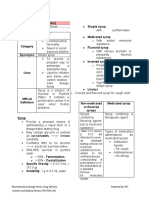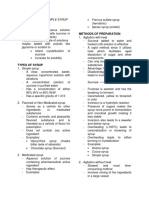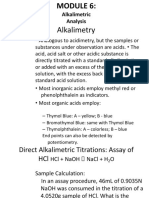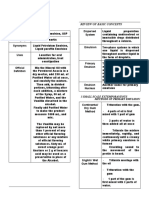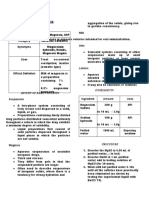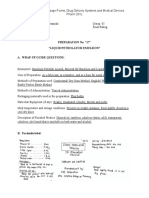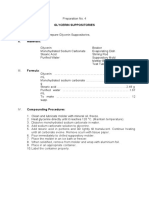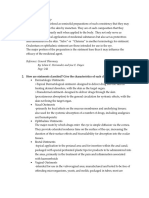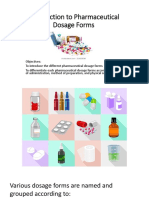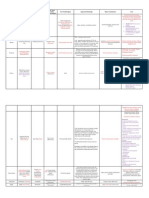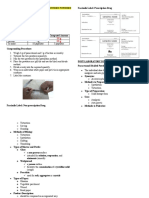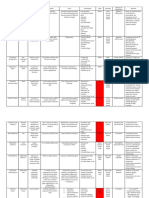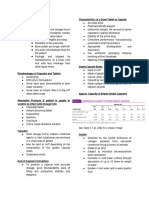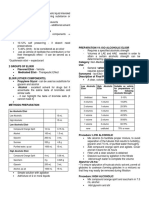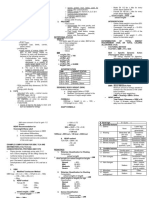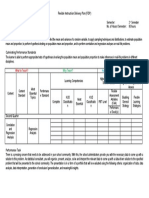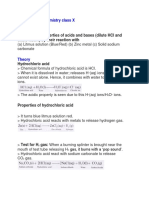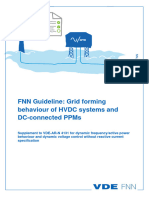0 ratings0% found this document useful (0 votes)
399 viewsPreparation 16 17
Preparation 16 17
Uploaded by
Mikaela LaoThis document describes the components and preparation of syrups. It defines syrup as a concentrated aqueous solution of sugar or sugar substitute, which may contain flavorings or medicinal agents. There are three main types of syrup: simple syrup containing only sugar and water, medicated syrup containing active ingredients, and flavored syrup used as a vehicle for other liquids. Syrup preparation involves heating sugar and water until dissolved to the desired concentration, and may incorporate additional steps for heat-sensitive substances or those requiring percolation. Common syrups are described including their ingredients, proportions, preparation methods, and intended uses.
Copyright:
© All Rights Reserved
Available Formats
Download as PDF, TXT or read online from Scribd
Preparation 16 17
Preparation 16 17
Uploaded by
Mikaela Lao0 ratings0% found this document useful (0 votes)
399 views3 pagesThis document describes the components and preparation of syrups. It defines syrup as a concentrated aqueous solution of sugar or sugar substitute, which may contain flavorings or medicinal agents. There are three main types of syrup: simple syrup containing only sugar and water, medicated syrup containing active ingredients, and flavored syrup used as a vehicle for other liquids. Syrup preparation involves heating sugar and water until dissolved to the desired concentration, and may incorporate additional steps for heat-sensitive substances or those requiring percolation. Common syrups are described including their ingredients, proportions, preparation methods, and intended uses.
Original Description:
school
Copyright
© © All Rights Reserved
Available Formats
PDF, TXT or read online from Scribd
Share this document
Did you find this document useful?
Is this content inappropriate?
This document describes the components and preparation of syrups. It defines syrup as a concentrated aqueous solution of sugar or sugar substitute, which may contain flavorings or medicinal agents. There are three main types of syrup: simple syrup containing only sugar and water, medicated syrup containing active ingredients, and flavored syrup used as a vehicle for other liquids. Syrup preparation involves heating sugar and water until dissolved to the desired concentration, and may incorporate additional steps for heat-sensitive substances or those requiring percolation. Common syrups are described including their ingredients, proportions, preparation methods, and intended uses.
Copyright:
© All Rights Reserved
Available Formats
Download as PDF, TXT or read online from Scribd
Download as pdf or txt
0 ratings0% found this document useful (0 votes)
399 views3 pagesPreparation 16 17
Preparation 16 17
Uploaded by
Mikaela LaoThis document describes the components and preparation of syrups. It defines syrup as a concentrated aqueous solution of sugar or sugar substitute, which may contain flavorings or medicinal agents. There are three main types of syrup: simple syrup containing only sugar and water, medicated syrup containing active ingredients, and flavored syrup used as a vehicle for other liquids. Syrup preparation involves heating sugar and water until dissolved to the desired concentration, and may incorporate additional steps for heat-sensitive substances or those requiring percolation. Common syrups are described including their ingredients, proportions, preparation methods, and intended uses.
Copyright:
© All Rights Reserved
Available Formats
Download as PDF, TXT or read online from Scribd
Download as pdf or txt
You are on page 1of 3
SYRUP ✓ Chocolate – serve as flavorant
• Concentrated solution of a sugar usually Method of Preparation
sucrose in water
1. Solution with the aid of Heat
• Concentrated aqueous solutions of a sugar
/ sugar substitute with or without added ✓ Sucrose is added to water and heated until
flavoring agent and medicinal agent solution is effected
(substances) sugar substitutes ✓ Endpoint: syrup should be clear
• Sugars = sucrose ✓ Advantage: FAST
✓ Disadvantage: Excessive heating will
5 Components of Syrup cause inversion of sucrose - glucose +
• Sugar / sugar substitutes – Polyols -> fructose (sweeter, with an increase
polyhydric alcohols (example: sorbitol and tendency to ferment) or recrystallize
gylcerol) maybe added to retard ✓ Caramelize, yellowish to brownish in color
crystallization of sucrose and enhance ✓ For heat stable substance
solubility ✓ Examples: Acacia syrup, cocoa syrup,
• Antimicrobial preservatives syrup USP
• Flavorants - mask the taste of the drug 2. Solution without the aid of Heat
• Colorants – match the flavorants
• Stabilizers ✓ Advantage: For substance that are heat
sensitive
3 Kinds of Syrup ✓ Disadvantage: Slowest and time-
consuming method
1. Simple Syrup
✓ Example : Ferrous Sulfate
✓ Clear, concentrated, sweet, aqueous,
3. Percolation
hypertonic solution with striations
✓ Its concentration is either 85% w/v or 65% ✓ Permits the purified water to pass slowly
w/w through a bed of crystalline sucrose to
✓ Specific gravity of 1.313 dissolve it
✓ SELF PRESERVING ✓ Use percolator
✓ Non medicated ✓ Rate: 20gtts/min
✓ Serve as vehicle for active drugs – need ✓ Examples: Tolu Balsam, Simple syrup
ng preservative if it act as a vehicle
4. Addition of sucrose to a medicated liquid
2. Medicated Syrup
✓ simple admixture of sugar to a prepared
✓ Aqueous solution of sucrose that contains liquids like fluidextract or a tincture
pharmaceutically active ingredients and ✓ Tincture – solution with an alcohol based
has a therapeutic effect ✓ the syrup prepared through this is not self
✓ Examples: Ferrous sulfate, Ipepac preserving
✓ Example: Senna Syrup
3. Flavored Syrup
✓ Contains aromatic and pleasantly flavored
substance and is intended as a vehicle or
flavor for prescription
✓ It does not contain an active ingredient
✓ Glycyrrhiza to mask bitter taste of alkaloids
SARTO, Neil Jeremy C.
1E-PH
SIMPLE SYRUP 1. Weigh the desired amount of ingredients
2. Prepare the percolation set up
✓ A good syrup has a specific gravity of not
3. Place the moistened cotton into the neck of
less than 1.33 and the concentration
the percolator to control the flow rate. Once
should be 85% w/v or 65% w/w
20 gtts/min flow rate – clip the rubber
✓ 60 - 80% concentration makes the syrup
tubing
self preserving
4. Place the sucrose
✓ 60% concentration prone to microbial
5. Place the circular filter paper above the
growth
sucrose and place the marbles on top of
✓ 85% concentration can crystallize the
the filter paper.
sucrose present
6. Pour 27.78 mL of water gently in a circular
Preparation 16 manner.
7. Cover with watch glass or bond paper
SIMPLE SYRUP 8. Let the set up stand for 2 days
Synonyms 9. Collect the percolate
10. Place into suitable container
✓ Syrupus
✓ Sirup, syrup Method of Preparation: Percolation
Description of Final Product Label: White label
✓ Clear solution of sucrose in purified water Container: 60 mL Flint bottle
Use/s: Remarks:
✓ Sweetening agent ✓ Tight cotton inhibits the flow of liquid
✓ Sweet vehicle and as basis for many ✓ Loose cotton will permit the sucrose flow
flavored and medicated syrup freely
✓ Filter paper is used to prevent holing of
Formulation sugar
Ingredients OA CA
Sucrose 850 g 382.5 g
Purified water, qs ad 1000 mL 208.35 mL
Procedure:
Water
Marble
Sucrose
Cotton
Clean and dry erlenmeyer flask
Evaporating disk
SARTO, Neil Jeremy C.
1E-PH
Preparation 17 syrup having a minimum tendency to
separate
CHOCOLATE SYRUP
✓ Sodium benzoate and glycerin are
Category: Syrup preservatives added to prevent bacterial
and mold growth when sucrose
Synonyms: concentration is low.
✓ Cacao Syrup
✓ Chocolate Flavored Syrup
Description of Final Product: Viscous, dark
brown syrup with the odor and taste of cocoa
Use: Flavored vehicle
Formulation
Ingredients OA CA
Cocoa 180 g 27 g
Sucrose 600 g 9.0 g
Glucose 180 g 1.75mL
Glycerin 50 mL 0.75 mL
Sodium Chloride 2g 0.03 g
Vanillin 0.2 g 0.003 g
Sodium benzoate 1g 0.015 g
Purified water, qs ad 1000 mL 15 mL
Density of Glucose: 1.54 g/mL
Procedure:
1. Dissolve glucose in glycerin
2. Dissolve sodium chloride, vanillin, sodium
benzoate in 6 mL hot water
3. Mix 1 and 2
4. Triturate cocoa and sucrose. Add # 3
5. Heat the mixture to boiling for 3 minutes
6. Cool
7. Add sufficient amount of water
Label: White label
Container: 15 mL amber bottle
Method of Preparation: Solution with the aid of
heat
Remarks:
✓ Cocoa containing NMT 12% non-volatile
ether soluble extractives or fats yields
SARTO, Neil Jeremy C.
1E-PH
You might also like
- Preparation 19: Iso-Alcoholic Elixir: 3 GttsDocument16 pagesPreparation 19: Iso-Alcoholic Elixir: 3 GttsMikaela LaoNo ratings yet
- MATH - P6 - Chapter 9 Practice 2Document12 pagesMATH - P6 - Chapter 9 Practice 2Titin ChayankNo ratings yet
- Dds Laboratory Preparation 2: Magnesium Citrate Oral SolutionDocument4 pagesDds Laboratory Preparation 2: Magnesium Citrate Oral SolutionKate MendozaNo ratings yet
- Dispensing2 Lab - RX 7-12Document3 pagesDispensing2 Lab - RX 7-12Alyssa Erika AzoresNo ratings yet
- PHA6111 Lab ACTIVITY 2 HERNANDEZDocument4 pagesPHA6111 Lab ACTIVITY 2 HERNANDEZGrace HernandezNo ratings yet
- Pharmaceutical Dosage FormsDocument10 pagesPharmaceutical Dosage FormsprinceamitNo ratings yet
- Preparation 21Document14 pagesPreparation 21Khael100% (1)
- Compare Liquid Dosage Form and Solid Dosage Form Base On Their Advantages and DisadvantagesDocument4 pagesCompare Liquid Dosage Form and Solid Dosage Form Base On Their Advantages and Disadvantagessybyl formenteraNo ratings yet
- Prep 9 White Ointment-PharcenDocument7 pagesPrep 9 White Ointment-PharcenKate MendozaNo ratings yet
- BOP Shear Pressure Calculations Rev 1 PDFDocument3 pagesBOP Shear Pressure Calculations Rev 1 PDFflasher_for_nokiaNo ratings yet
- PHARDOSE - Preparations 16-18 ReviewerDocument3 pagesPHARDOSE - Preparations 16-18 ReviewerFrances Jeiliane Javier0% (1)
- Preparation 1: Syrup: Types of Syrup DDS (Laboratory)Document5 pagesPreparation 1: Syrup: Types of Syrup DDS (Laboratory)Kate MendozaNo ratings yet
- Prep 10 PostlabDocument2 pagesPrep 10 PostlabKate MendozaNo ratings yet
- Preparations 11 15Document31 pagesPreparations 11 15Breanne Pearl Angelie Dumbrique0% (2)
- PHAR 3 Preparation 16 Simple SyrupDocument2 pagesPHAR 3 Preparation 16 Simple SyrupDr.Ramkaran SainiNo ratings yet
- MODULE 6 Alkalimetric AnalysisDocument16 pagesMODULE 6 Alkalimetric AnalysisMrl AshiaNo ratings yet
- Lab Manual (Activity 6)Document1 pageLab Manual (Activity 6)Jaifah AzaleahNo ratings yet
- DDS FINALS Compiled ReviewerDocument21 pagesDDS FINALS Compiled ReviewerChantelle Mea100% (1)
- Mineral Oil Emulsion: Dispersed System Official Title Category SynonymsDocument4 pagesMineral Oil Emulsion: Dispersed System Official Title Category SynonymsKate MendozaNo ratings yet
- DDS Laboratory Activities - Prep 5-13Document32 pagesDDS Laboratory Activities - Prep 5-13ja_QuinineNo ratings yet
- Milk of Magnesia, USP Antacid Cathartic Magnesium Hydroxide, Rolaids, Magnesia MagmaDocument3 pagesMilk of Magnesia, USP Antacid Cathartic Magnesium Hydroxide, Rolaids, Magnesia MagmaKate MendozaNo ratings yet
- Solution, Solubility and Factors Affecting SolubilityDocument6 pagesSolution, Solubility and Factors Affecting Solubilityshehryar khanNo ratings yet
- Dispensing2 Lab - Therapeutic IncompatibilitiesDocument2 pagesDispensing2 Lab - Therapeutic IncompatibilitiesAlyssa Erika Azores100% (1)
- Physical Pharmacy Lab - Post LabsDocument90 pagesPhysical Pharmacy Lab - Post LabsFlorence Lynn BaisacNo ratings yet
- PHAR3 LAB - Preparation 22-30Document2 pagesPHAR3 LAB - Preparation 22-30Gerard LeeNo ratings yet
- Preparation # I. Objectives:: Pharmaceutical Dosage Forms Laboratory ManualDocument2 pagesPreparation # I. Objectives:: Pharmaceutical Dosage Forms Laboratory Manuallalag yanNo ratings yet
- Homework No.1: Manucum, Ivan-Leomard T. March 25, 2020 Group 3 PharmacognosyDocument3 pagesHomework No.1: Manucum, Ivan-Leomard T. March 25, 2020 Group 3 PharmacognosyArmanRenzTVNo ratings yet
- Preparation 2: Calcium Hydroxide Topical Solution: Dds LabDocument4 pagesPreparation 2: Calcium Hydroxide Topical Solution: Dds LabKate MendozaNo ratings yet
- Steroids: Pharmacognosy #6Document23 pagesSteroids: Pharmacognosy #6Arman Renz PauloNo ratings yet
- Name:: Pharmaceutical Dosage Forms (Phar 3) Laboratory ManualDocument9 pagesName:: Pharmaceutical Dosage Forms (Phar 3) Laboratory ManualChristian Paulo D. PichayNo ratings yet
- Preparation No. "17" "Liquid Petrolatum Emulsion" A. Wrap-Up Guide QuestionsDocument5 pagesPreparation No. "17" "Liquid Petrolatum Emulsion" A. Wrap-Up Guide QuestionsMEDELYN KEITH ESTANISLAONo ratings yet
- Aromatic Waters - Liniments Lab NotesDocument9 pagesAromatic Waters - Liniments Lab NotesElaine Sombrano100% (8)
- Midterm DDS Lab Activity 2 - Group 01Document6 pagesMidterm DDS Lab Activity 2 - Group 01Omie PumbybyNo ratings yet
- PH 107 DDS Lab Midterm NotesDocument11 pagesPH 107 DDS Lab Midterm NotesKrsna NaveraNo ratings yet
- Cold Cream USPDocument4 pagesCold Cream USPRon OlegarioNo ratings yet
- 1 Introduction To Pharmaceutical Dosage Forms Part1Document32 pages1 Introduction To Pharmaceutical Dosage Forms Part1Joanna Carla Marmonejo Estorninos-Walker100% (1)
- Experiment P'ceuticsDocument4 pagesExperiment P'ceuticsnigamnirupam50% (2)
- Preparation #13: Calcium Hydroxide Topical Solution Post Lab QuestionsDocument1 pagePreparation #13: Calcium Hydroxide Topical Solution Post Lab QuestionsJANNIE BELLE RODRIGUEZ50% (2)
- Pcog Notes GlycosidesDocument8 pagesPcog Notes GlycosidesAlexandra Venice ChuaNo ratings yet
- PH-PHR 223 Pharmacognosy and Plant Chemistry LEC: @mei - Sria !1Document7 pagesPH-PHR 223 Pharmacognosy and Plant Chemistry LEC: @mei - Sria !1Seania BuenaventuraNo ratings yet
- Preparation #: Paracetamol Tablets I. Objectives:: Pharmaceutical Dosage Forms Laboratory ManualDocument2 pagesPreparation #: Paracetamol Tablets I. Objectives:: Pharmaceutical Dosage Forms Laboratory Manuallalag yanNo ratings yet
- Pharm 222L - Activity 1 - Group5Document9 pagesPharm 222L - Activity 1 - Group5france hambon100% (1)
- Phan111lec FinalsDocument34 pagesPhan111lec FinalsANDREA ROSELLE FULLONANo ratings yet
- Aspirin ExpDocument4 pagesAspirin ExpLyrojen Mae TorralbaNo ratings yet
- 02 Preparation 1 and 2Document4 pages02 Preparation 1 and 2James AzurinNo ratings yet
- PHA 070 Dispensing 2 P1 REVIEWER From QuizzizDocument6 pagesPHA 070 Dispensing 2 P1 REVIEWER From Quizzizjenet soleil100% (1)
- Course Plan 2019 - Pha 617 (Pharmacy Administration, Leadership, and Management)Document14 pagesCourse Plan 2019 - Pha 617 (Pharmacy Administration, Leadership, and Management)Grace Hernandez100% (1)
- 03 Solutions PDFDocument77 pages03 Solutions PDFIra MoranteNo ratings yet
- Cinnamon Water: Preparation Category Synonyms Description of Final Product Use/s IngredientsDocument6 pagesCinnamon Water: Preparation Category Synonyms Description of Final Product Use/s IngredientsMaan EspirituNo ratings yet
- Pha6111 Dispensing Lab Customer Service PDFDocument5 pagesPha6111 Dispensing Lab Customer Service PDFKATHLEEN CALALANGNo ratings yet
- Preparation #11: Cinnamon Water Post Lab QuestionsDocument1 pagePreparation #11: Cinnamon Water Post Lab QuestionsJANNIE BELLE RODRIGUEZNo ratings yet
- Phardose Lab (Aromatic Water - Dakin's)Document5 pagesPhardose Lab (Aromatic Water - Dakin's)Sharmaine Margaret LeeNo ratings yet
- Preparation No. "20" "NF Mouthwash" A. Wrap-Up Guide QuestionsDocument5 pagesPreparation No. "20" "NF Mouthwash" A. Wrap-Up Guide QuestionsMEDELYN KEITH ESTANISLAO100% (1)
- Magnesium Citrate Solution I. Objective: To Prepare Magnesium Citrate Solution II. MaterialsDocument2 pagesMagnesium Citrate Solution I. Objective: To Prepare Magnesium Citrate Solution II. Materialsسلطانة عبد اللهNo ratings yet
- Post Lab 1 and 2Document5 pagesPost Lab 1 and 2Nikol BaltazarNo ratings yet
- PHA619 LEC 1st ShiftDocument35 pagesPHA619 LEC 1st ShiftrenNo ratings yet
- Activity #3Document9 pagesActivity #3PrincessNo ratings yet
- Pharmaceutical Aids and Necessities (Report Pharchem 1-Group 1)Document109 pagesPharmaceutical Aids and Necessities (Report Pharchem 1-Group 1)NicoleTrishiaDeparineNo ratings yet
- 0lab Prep 19 31Document3 pages0lab Prep 19 31Denise Yanci DemiarNo ratings yet
- Pharmaceutical Dosage Forms Laboratory ManualDocument2 pagesPharmaceutical Dosage Forms Laboratory Manuallalag yanNo ratings yet
- The politics of hunger: Protest, poverty and policy in England, <i>c.</i> 1750–<i>c.</i> 1840From EverandThe politics of hunger: Protest, poverty and policy in England, <i>c.</i> 1750–<i>c.</i> 1840No ratings yet
- SYRUPSDocument3 pagesSYRUPSAnnamae MartinNo ratings yet
- Experiments MIdterms LAB PDDSDocument8 pagesExperiments MIdterms LAB PDDSErika TorresNo ratings yet
- PHA619 1st Shifting Supplement Notes PDFDocument1 pagePHA619 1st Shifting Supplement Notes PDFMikaela Lao100% (1)
- Capsules PDFDocument8 pagesCapsules PDFMikaela LaoNo ratings yet
- Aluminum HydroxideDocument1 pageAluminum HydroxideMikaela LaoNo ratings yet
- Editedprep 28 30Document1 pageEditedprep 28 30Mikaela LaoNo ratings yet
- Organizational CommunicationDocument1 pageOrganizational CommunicationMikaela LaoNo ratings yet
- Evaluation Sepak GRP4Document1 pageEvaluation Sepak GRP4Mikaela LaoNo ratings yet
- 3RD Shifting Phardosage Lab ReviewerDocument14 pages3RD Shifting Phardosage Lab ReviewerMikaela LaoNo ratings yet
- RespiratoryDocument1 pageRespiratoryMikaela LaoNo ratings yet
- RespiratoryDocument1 pageRespiratoryMikaela LaoNo ratings yet
- Health System Nutrition and DietDocument2 pagesHealth System Nutrition and DietMikaela LaoNo ratings yet
- 0.15mL 1.5mL 3mL 4.8mLDocument4 pages0.15mL 1.5mL 3mL 4.8mLMikaela LaoNo ratings yet
- CardiovascularDocument1 pageCardiovascularMikaela LaoNo ratings yet
- Long Bondpaper LabelDocument1 pageLong Bondpaper LabelMikaela LaoNo ratings yet
- Lecture Notes On OrganizingDocument10 pagesLecture Notes On OrganizingMikaela LaoNo ratings yet
- Bompelly Ravi K 201305 PHDDocument173 pagesBompelly Ravi K 201305 PHDPersian GulfNo ratings yet
- Manual For Air TankDocument5 pagesManual For Air TanklateraNo ratings yet
- Iit Jam Physics 2008Document5 pagesIit Jam Physics 2008s_adhyaNo ratings yet
- Cat 950 H PDFDocument20 pagesCat 950 H PDFdk_moehammedNo ratings yet
- Flexible Instruction Delivery Plan (FIDP) Grade: Semester: Core Subject Title: No. of Hours/ Semester: Core Subject DescriptionDocument1 pageFlexible Instruction Delivery Plan (FIDP) Grade: Semester: Core Subject Title: No. of Hours/ Semester: Core Subject DescriptionJoy TamalaNo ratings yet
- Unit 5 - Digital System Design - WWW - Rgpvnotes.inDocument8 pagesUnit 5 - Digital System Design - WWW - Rgpvnotes.intejasshroff0303No ratings yet
- YOLOV10 ExplainedDocument13 pagesYOLOV10 ExplainedSushma MNo ratings yet
- Introduction To Chemistry and Its Branches - Print - QuizizzDocument3 pagesIntroduction To Chemistry and Its Branches - Print - Quizizzandie100% (3)
- To Study The Properties of Acids and Bases (Dilute HCL and Dilute Naoh) by Their Reaction WithDocument7 pagesTo Study The Properties of Acids and Bases (Dilute HCL and Dilute Naoh) by Their Reaction Withabhinav dixitNo ratings yet
- TPD1707E2Document90 pagesTPD1707E2Stefano GrandiNo ratings yet
- CS3251 (UNIT 4) NOTES EduEnggDocument27 pagesCS3251 (UNIT 4) NOTES EduEnggAravind SamyNo ratings yet
- GTT CS1Document4 pagesGTT CS1iuliiulianNo ratings yet
- Direct Indirect SpeechDocument2 pagesDirect Indirect Speechdanyal khanNo ratings yet
- Case Study 1Document3 pagesCase Study 1Vinay MishraNo ratings yet
- Science: Quarter 4 - Module 3: You Keep Me WarmDocument34 pagesScience: Quarter 4 - Module 3: You Keep Me WarmMercy Mangaoil83% (6)
- Lab Report VibrationDocument5 pagesLab Report Vibrationinterdex_006No ratings yet
- Overall Heat Transfer CoefficientDocument3 pagesOverall Heat Transfer CoefficientcordobaluisfNo ratings yet
- Name: - Program & Year: - Section: - Student No.: - Seat No.: - Signature: - Date: - Problem Set PS3.2 ScoreDocument2 pagesName: - Program & Year: - Section: - Student No.: - Seat No.: - Signature: - Date: - Problem Set PS3.2 ScoreJustin ViberNo ratings yet
- Additives or ModifiersDocument3 pagesAdditives or Modifiersberchard0% (1)
- Desktop Video ManualDocument870 pagesDesktop Video ManualDiogo GarciaNo ratings yet
- OBIEE Course Contents - v1Document6 pagesOBIEE Course Contents - v1Amit SharmaNo ratings yet
- Homeostasis Presentation 22.10Document38 pagesHomeostasis Presentation 22.10Samreen JawaidNo ratings yet
- FNN Guideline Grid Forming Behaviour of HVDC Systems and DC-connected PPMs - InhaltDocument3 pagesFNN Guideline Grid Forming Behaviour of HVDC Systems and DC-connected PPMs - InhalttaigerasNo ratings yet
- Technical Description: Type: 810.001.210Document6 pagesTechnical Description: Type: 810.001.210Radu VasilacheNo ratings yet
- Solutions To Probability BookDocument200 pagesSolutions To Probability BookNilesh ThakurNo ratings yet
- 002 - Gas ChromatographDocument52 pages002 - Gas Chromatographtubagus syarief100% (2)
- EBM Pabst - CPAP - BlowerDocument4 pagesEBM Pabst - CPAP - BlowerlouisNo ratings yet











